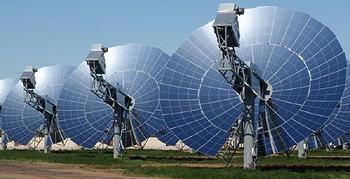Mirrored Solar Dishes to March Across California Desert
WASHINGTON, DC, October 20, 2010 (ENS) – More mirrored Suncatcher solar dishes will be generating grid-quality electricity on federal public lands in California after today’s approval of a proposal by Tessera Solar of Texas to site dishes in San Bernardino County.
Secretary of the Interior Ken Salazar today signed off on Tessera’s Calico Solar Project, the fifth large-scale solar energy project to be approved on U.S. public lands this month.
“The Calico Solar Project is one of several projects in the pipeline that will help California and this nation build a renewable energy economy,” Secretary Salazar said in signing the Record of Decision. “With each project, we are helping to create new jobs for American workers, reduce carbon emissions, promote energy independence and strengthen our national security.”
 |
Stirling’s SunCatcher solar dishes will be placed on California public lands. (Photo courtesy Stirling Energy Systems) |
The Calico project site is on 4,604 acres of public lands in Southern California’s Mojave Desert, 37 miles east of Barstow and 115 miles east of Los Angeles.
Earlier this month, Secretary Salazar approved Tessera’s Imperial Valley Solar Project, which also uses Stirling Energy System’s SunCatcher technology.
The Calico Solar Project is expected to produce over 663.5 megawatts of renewable energy, or enough to power 200,000 to 500,000 homes and generate more than 500 new jobs.
The Imperial Valley Solar Project is located on 6,571 acres in Imperial County, 14 miles west of El Centro. Phase 1 of the project will generate 300 MW of power under a 20-year power purchase agreement with San Diego Gas & Electric. Phase 2 of the project will generate an additional 409 MW.
Most of the power from these projects will be generated at peak times, when the demand for electricity is greatest.
Earlier this month, the Salazar approved the first four renewable energy projects on public lands, three in California – the Imperial Valley project, the Chevron Lucerne Valley Solar Project, and the Ivanpah Solar Electric Generating System, and one in Nevada, the Silver State North Solar Project.
In total, the five approved solar projects could generate over 1,800 megawatts of renewable energy, or enough to power up to 1.4 million homes, the Interior Department estimates.
The secretary’s decision today authorizes Interior’s Bureau of Land Management to offer Tessera Solar a right-of-way grant to use these public lands for 30 years if all rents and other conditions are met.
“This marks the fifth solar energy project approved on public lands in the last two weeks,” said BLM Director Bob Abbey. “Through these approvals, along with recent approvals for transmission lines and other renewable energy infrastructure, we are continuing to make significant contributions to this nation’s renewable energy generation capabilities.”
The Calico project has undergone extensive environmental review, starting with public scoping in June 2009, followed by a draft environment impact statement and full public involvement in April. A final EIS was issued in August.
During the environmental impact reviews, the BLM altered Tessera Solar’s proposal to reduce its impact.
The project size was reduced from 8,230 acres to 4,604 acres to limit impacts on the threatened desert tortoise and its habitat, reducing the number of tortoises affected by the project from 107 down to 22 animals.
Plagued by habitat loss and respiratory infection, the desert tortoise was listed as threatened on the California Endangered Species List in 1989 and on the Federal list in 1990.
This species of tortoise, Gopherus agassizii, is native to the Mojave desert and Sonoran desert of the southwestern United States and northern Mexico and is considered California’s state reptile.
The smaller Calico project footprint retains more than 1,600 additional acres of high-value wildlife habitat for desert tortoises, bighorn sheep and other wildlife along the foothills of the Cady Mountains.
Tessera Solar is providing funding to the BLM for more than 10,000 acres of desert tortoise and Mojave fringe-toed lizard habitat to mitigate the project’s impacts.
In addition, specially designated Environmentally Sensitive Areas will be established on the Calico project site to protect sensitive plant species.
Calico is one of the projects jointly processed through the BLM and the California Energy Commission cooperative model established by an October 12, 2009 agreement between Secretary Salazar and California Governor Arnold Schwarzenegger. The agreement directed Interior and state agencies to create an initiative to advance development of environmentally appropriate renewable energy on U.S. lands in California.
The California Energy Commission’s Siting Committee recommended the project for approval on September 25, 2010, and a hearing before the full Commission has been set for October 28, 2010.
The Stirling Energy Systems SunCatcher is a 25-kilowatt solar power system that uses a 38-foot, mirrored parabolic dish combined with an automatic tracking system to collect and focus the Sun’s energy onto a Stirling engine to convert the solar thermal energy into electricity.
SunCatcher has the highest solar-to-grid electric efficiency, uses no water for power production, features a modular and scalable design, low capital cost, and minimal land disturbance. SunCatcher was designed and developed in the United States, through a public-private partnership with the U.S. Department of Energy.
Stirling CEO Steve Cowman said, “The SunCatcher represents the next generation of grid-quality solar power technology providing clean, reliable and cost-effective solar power to address global climate change and reduce our planet’s carbon emissions.”
Through the American Recovery and Reinvestment Act, renewable energy developers whose projects begin construction by the end of 2010 can apply for payments of up to 30 percent of the eligible costs of the project. Tessera Solar is also eligible to apply for funding through the Department of Energy’s Recovery Act conditional loan guarantee program.
Copyright Environment News Service (ENS) 2010. All rights reserved.
